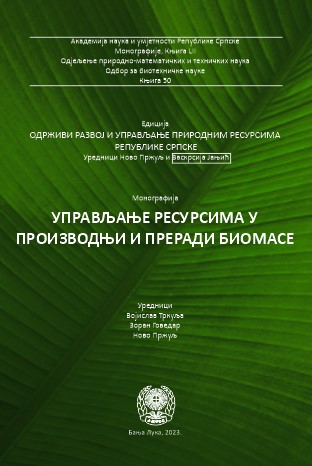Use of biomass for biofuel production
DOI:
https://doi.org/10.7251/EORU2306367RKeywords:
Biomass, biogas, energy, substrate, fermentation, alternative fuelsAbstract
Plant biomass is the largest renewable energy source. Republic of Srpska and the Republic of Serbia are among the top European countries in terms of the amount of available and unused biomass. Biogas is a product obtained by anaerobic decomposition of organic matter with the help of a complex of microorganisms in biogas power plants. All types of biomass which contains carbohydrates, proteins, fats, cellulose and hemicellulose can be used to obtain biogas. In theoretical terms, biogas can be produced from any substrate of organic origin. Also, there are possibilities to combine different types of substrates in one biogas plant. However, there are technical or economic limitations to this, which is why it is best to use several types of substrates of different origins in practice. Depending on the physical state, substrates are divided into solid and liquid. Liquid substrates include sewage and various wastewaters with a significant content of organic matter, while solid substrates include manure, various types of silage, food waste, solid organic municipal waste and other types of organic waste. The special importance of the production and use of biogas, as a type of renewable energy source, is the prevention of emissions of methane, a gas that increases the greenhouse effect (the intensity is 23 times higher than carbon dioxide). Also, the use of biogas as a fuel, most often produces electricity, and thus contributes to the realization of the set goals of greater use of renewable energy sources. An additional positive impact is the reduction of the spread of unpleasant odors, prevention of soil and groundwater pollution. Positive socioeconomic effects are also being achieved, rural development is being encouraged, and human and material resources are being used better at the local level. When studying the possibilities of biogas production, the quantities and prices of individual substrates are first considered. Their characteristics are analyzed, which determine the potential for biogas production, and thus the size of the biogas plant. Only a small part of the liquid and solid biomass in the fermentation plant is transformed into biogas. The rest of this process needs to be taken care of and used in an adequate way. The rest of the fermentation is aby-product in the production of biogas, and it is most often used as a fertilizer. It contains plant nutrients and organic matter, and by returning to agricultural areas, it contributes to preserving the fertility of the land. One of the ways to use the rest of the fermentation is to produce pellets or briquettes after separation and drying, and to use it as a solid fuel. Thanks to the development of new technologies for processing bio-waste into energy, the rate of increase in the use of alternative fuels is growing significantly.
